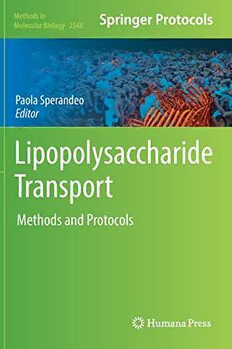Table Of ContentMethods in
Molecular Biology 2548
Paola Sperandeo
Editor
Lipopolysaccharide
Transport
Methods and Protocols
M M B
ETHODS IN OLECULAR IO LO GY
SeriesEditor
JohnM.Walker
School of Lifeand MedicalSciences
University ofHertfordshire
Hatfield, Hertfordshire, UK
Forfurther volumes:
http://www.springer.com/series/7651
For over 35 years, biological scientists have come to rely on the research protocols and
methodologiesinthecriticallyacclaimedMethodsinMolecularBiologyseries.Theserieswas
thefirsttointroducethestep-by-stepprotocolsapproachthathasbecomethestandardinall
biomedicalprotocolpublishing.Eachprotocolisprovidedinreadily-reproduciblestep-by-
step fashion, opening with an introductory overview, a list of the materials and reagents
neededtocompletetheexperiment,andfollowedbyadetailedprocedurethatissupported
with a helpful notes section offering tips and tricks of the trade as well as troubleshooting
advice. These hallmark features were introduced by series editor Dr. John Walker and
constitutethekeyingredientineachandeveryvolumeoftheMethodsinMolecularBiology
series. Tested and trusted, comprehensive and reliable, all protocols from the series are
indexedinPubMed.
Lipopolysaccharide Transport
Methods and Protocols
Edited by
Paola Sperandeo
Department of Pharmacological and Biomolecular Sciences, Università degli Studi di Milano, Milan, Italy
Editor
PaolaSperandeo
DepartmentofPharmacologicaland
BiomolecularSciences
Universita`degliStudidiMilano
Milan,Italy
ISSN1064-3745 ISSN1940-6029 (electronic)
MethodsinMolecularBiology
ISBN978-1-0716-2580-4 ISBN978-1-0716-2581-1 (eBook)
https://doi.org/10.1007/978-1-0716-2581-1
©TheEditor(s)(ifapplicable)andTheAuthor(s),underexclusivelicensetoSpringerScience+BusinessMedia,LLC,part
ofSpringerNature2022
Thisworkissubjecttocopyright.AllrightsaresolelyandexclusivelylicensedbythePublisher,whetherthewholeorpart
of the material is concerned, specifically the rights of translation, reprinting, reuse of illustrations, recitation,
broadcasting,reproductionon microfilmsorinanyotherphysicalway,andtransmissionorinformation storageand
retrieval,electronicadaptation, computersoftware,orbysimilar ordissimilar methodologynow knownorhereafter
developed.
Theuseofgeneraldescriptivenames,registerednames,trademarks,servicemarks,etc.inthispublicationdoesnotimply,
evenintheabsenceofaspecificstatement,thatsuchnamesareexemptfromtherelevantprotectivelawsandregulations
andthereforefreeforgeneraluse.
Thepublisher,theauthorsandtheeditorsaresafetoassumethattheadviceandinformationinthisbookarebelievedto
betrueandaccurateatthedateofpublication.Neitherthepublishernortheauthorsortheeditorsgiveawarranty,
expressedorimplied,withrespecttothematerialcontainedhereinorforanyerrorsoromissionsthatmayhavebeen
made.Thepublisherremainsneutralwithregardtojurisdictionalclaimsinpublishedmapsandinstitutionalaffiliations.
ThisHumanaimprintispublishedbytheregisteredcompanySpringerScience+BusinessMedia,LLC,partofSpringer
Nature.
Theregisteredcompanyaddressis:1NewYorkPlaza,NewYork,NY10004,U.S.A.
Preface
ThedistinctivefeatureofGram-negativebacteriaisadoublemembranecellenvelopewhich
greatly impacts on the physiology of this wide group of microorganisms. This cellular
structure, involving an inner and an outer membrane, is essential for bacterial survival
especially in the natural environment, where it represents the point of interaction with the
external milieu and, in the case of pathogens, with the host immune system. The outer
membrane not only contributes together with the peptidoglycan to give strength and
rigiditytothecellwall,withstandingtheturgorpressure,butalsoprovidesaphysicalbarrier
totheattackofnoxiousandpotentiallyharmfulmolecules,suchasmanyantibiotics.Infact,
itcarriesapanoplyofeffluxpumpsthatactivelyextrudethetoxicmoleculesoutsidethecell
preventingthemfromreachinghighenoughintracellularconcentrationstoexertabacteri-
cidaleffect.Butmostimportantly,theoutermembraneservesitselfasapermeabilitybarrier
toseveraldrugs,blockingthemfromdiffusingintotheperiplasmandthecytoplasmthanks
to its peculiar asymmetric structure that, unlike the inner membrane, is not made by a
phospholipidbilayer.
The asymmetry of the outer membrane is guaranteed by the presence of a unique
glycolipid,thelipopolysaccharides(LPS),intheouterleafletofthemembrane.Theamphi-
pathic nature of LPS, made up of a lipid anchor linked to a core oligosaccharide that is
furtherdecoratedbyavariablepolysaccharidechain,iscrucialforthedistinctivefunctionof
the outer membrane as permeability barrier. Nevertheless, the chemical proprieties of LPS
also pose several challenges to its biogenesis. In fact, like other components of the outer
membrane (i.e., proteins and phospholipids), LPS precursors are also synthesized in the
cytoplasm and need to be transported across subcellular compartments characterized by
differentphysicochemicalproprieties(theinnermembraneandtheperiplasm),beforebeing
assembled at the outer membrane. Importantly, periplasm and outer membrane are com-
partments devoid of energy thus posing an additional burden for LPS biogenesis. For this
reason, LPS trafficking across the cell envelope requires the intervention of proteins and
multiprotein machineries that harness the energy from ATP to overcome the thermody-
namicobstaclesandallowthepassageandassemblyofLPSprecursors.
The integrity of the whole process of LPS biogenesis is fundamental for bacterial
survival; therefore, molecules which interfere with any step of this process to inflict lethal
damagetotheoutermembranewouldrepresentpromisingstartingpointstodevelopnovel
antibacterialstrategies.
Tremendous effort has therefore been made during the past 50 years to expand the
knowledge on LPS biogenesis and identify unexplored mechanisms to be targeted by the
rationaldesignorscreeningofnovelantibiotics.
This volume is intended to bring together not only some of the most commonly used
protocols in this field of study, such as membrane fractionation by sucrose gradient centri-
fugationcoupledwithLPSprofiledetermination(describedinChap.4)and LPSchemical
analysisbymassspectrometry(describedinChap.12),butalsobiochemicalandbiophysical
techniques to study protein-protein (Chaps. 7, 9, and 10) and protein-LPS interaction
(Chaps. 6, 8, and 13) that proved useful for the characterization of proteins and multi-
v
vi Preface
protein machineries involved in LPS transport. Approaches to determine protein topology
andstructurearealsofundamentaltoelucidateLPStransportmechanismsandareincluded
(Chaps.5,11,14,and15).
Importantly,thediscoveryoffactorsinvolvedinLPSbiogenesisisgenerallyhinderedby
thelackofaspecificphenotypeandtheessentialityofmostofthegenes,whichhampersthe
construction of knock-out mutants. Therefore, the research on LPS transport is strictly
dependent on the development of clever genetic strategies to allow the analysis of this
process. This aspect is addressed in Chaps. 1, 2, and 3, which describe protocols for the
identification and the analysis of essential genes and crucial mutations in LPS transport-
relatedgenes.
Lastly, Chaps. 16 and 17 describe techniques to enable LPS visualization by confocal
microscopyandatomicforcemicroscopy.
Wehopethatthisvolumemightprovideanoverviewonhowmultidisciplinarythestudy
ofLPStransportshouldbetoensureaholisticunderstandingofsuchacrucialprocessand
toallowtheidentificationofnewpotentialAchille’sheelsoftheGram-negativebacterialcell
for thedevelopmentofinnovativeantibacterialstrategies.
I would like to express my deepest gratitude to all the authors contributing to this
volume,whometiculouslysharedtheyexpertiseintheirchapters.Finally,aspecialthanksis
due to the series Editor, Professor John Walker, for the great opportunity of editing this
volume.
Milan,Italy PaolaSperandeo
Contents
Preface ..................................................................... v
Contributors................................................................. ix
PART I GENETIC STRATEGIES TO STUDY ESSENTIAL LPS BIOGENESIS GENES
1 UseofMutagenesisandFunctionalScreenstoCharacterizeEssential
GenesInvolvedinLipopolysaccharideTransport..... ........ ....... ........ 3
AndrewWilson,CarlosIniguez,andNatividadRuiz
2 GenerationofStableandUnmarkedConditionalMutants
inPseudomonasaeruginosa.. ........ ....... ....... ........ ....... ........ 21
AlessandraLoSciuto,MariaConcettaSpinnato,
MartinaPasqua,andFrancescoImperi
3 AnalyzingtheFunctionofEssentialGenesbyPlasmidShuffling...... ........ 37
FedericaAnnaFalchi
PART II FUNCTIONAL ANALYSIS OF PROTEINS INVOLVED IN LPS TRANSPORT
4 MembraneFractionationbyIsopycnicSucroseDensityGradient
CentrifugationforQualitativeAnalysisofLPSinEscherichiacoli...... ........ 53
ElisabeteC.CardosoMendesMoura,AlessandraPolissi,
andPaolaSperandeo
5 ExploringtheTopologyofCytoplasmicMembraneProteinsInvolved
inLipopolysaccharideBiosynthesisbyinSilicoandBiochemicalAnalyses ... ... 71
JuliaMonjara´sFeriaandMiguelA.Valvano
6 UseofSite-DirectedSpinLabelingEPRSpectroscopytoStudy
Protein–LPSInteractions ........... ....... ....... ........ ....... ........ 83
KathrynM.SchultzandCandiceS.Klug
7 APhoto-CrosslinkingApproachtoMonitoringtheAssembly
ofanLptDIntermediatewithLptEinaLivingCell.......... ....... ........ 97
RyojiMiyazaki,HiroyukiMori,andYoshinoriAkiyama
8 MassSpectrometryAnalysisofDynamicsandInteractionsoftheLPS
TransloconLptDE......... ........ ....... ....... ........ ....... ... ..... 109
FrancescoFiorentinoandJaniR.Bolla
9 AffinityPurificationandCoimmunoprecipitationofTransenvelopeProtein
ComplexesinGram-NegativeBacteria....... ....... ........ ....... ........ 129
AlessandraM.Martorana,CarloSantambrogio,
andAlessandraPolissi
10 ABacterialTwo-HybridSystemforInVivoAssaysofProtein-Protein
InteractionsandDrugDiscovery .... ....... ....... ........ ....... ........ 145
DanielLadant
11 DetectingLipoproteinsSneakingOutoftheLipopolysaccharideLeaflet....... 169
NaemiCsoma,DidierColau,andJean-Franc¸oisCollet
vii
viii Contents
PARTIII TOOLSFORSTRUCTURALANALYSISOFLPSANDLPSTRANSPORTPROTEINS
12 DissectingLipopolysaccharideCompositionandStructurebyGC-MS
andMALDISpectrometry.......... ....... ....... ........ ....... ........ 181
PilarGarcia-Vello,ImmacolataSpeciale,FlavianaDiLorenzo,
AntonioMolinaro,andCristinaDeCastro
13 ProbingtheFunctionalInteractionInterfaceofLipopolysaccharide
andAntimicrobialPeptides:ASolution-StateNMRPerspective ...... ........ 211
KarishmaBiswasandAnirbanBhunia
14 Cryo-EMAnalysisoftheLipopolysaccharideFlippaseMsbA......... ........ 233
Franc¸oisA.The´lotandMaofuLiao
15 ProteinCrystallizationofTwoRecombinantLptProteins .... ....... ........ 249
MichelaBollatiandLouiseJ.Gourlay
PART IV MICROSCOPY-BASED APPROACHES
16 MetabolicIncorporationofAzido-SugarsintoLPStoEnableLive-Cell
FluorescenceImaging ...... ... .... ........ ....... ........ ....... ........ 267
IngaNilssonandDavidA.Six
17 UseofAtomicForceMicroscopytoCharacterizeLPSPerturbations.......... 279
YooJinOh
Index ...................................................................... 289
Contributors
YOSHINORIAKIYAMA • InstituteforFrontierLifeandMedicalSciences,KyotoUniversity,
Kyoto,Japan
ANIRBANBHUNIA • DepartmentofBiophysics,BoseInstitute,Kolkata,India
KARISHMABISWAS • DepartmentofBiophysics,BoseInstitute,Kolkata,India
JANIR.BOLLA • TheKavliInstituteforNanoscienceDiscovery,Oxford,UK;Departmentof
PlantSciences,UniversityofOxford,Oxford,UK
MICHELA BOLLATI • DepartmentofBiosciences,Universit`adegliStudidiMilano,Milan,
Italy;InstituteofBiophysics-CNR,Milan,Italy
ELISABETEC.CARDOSOMENDES MOURA • DepartmentofPharmacologicaland
BiomolecularSciences,Universit`adegliStudidiMilano,Milan,Italy
DIDIERCOLAU • deDuveInstitute,Universite´catholiquedeLouvainandWELBIO,Brussels,
Belgium
JEAN-FRANC¸OISCOLLET • deDuveInstitute,Universite´catholiquedeLouvainandWELBIO,
Brussels,Belgium
NAEMICSOMA • deDuveInstitute,Universite´catholiquedeLouvainandWELBIO,Brussels,
Belgium
CRISTINADECASTRO • DepartmentofAgriculturalSciences,UniversityofNaples,Portici,
(NA),Italy
FLAVIANADILORENZO • DepartmentofChemicalSciences,UniversityofNaples,Naples,
Italy
FEDERICA ANNAFALCHI • DepartmentofBiosciences,Universit`adegliStudidiMilano,
Milan,Italy
FRANCESCOFIORENTINO • DepartmentofDrugChemistryandTechnologies,Sapienza
UniversityofRome,Rome,Italy
PILARGARCIA-VELLO • DepartmentofChemicalSciences,UniversityofNaples,Naples,Italy
LOUISEJ.GOURLAY • DepartmentofBiosciences,Universit`adegliStudidiMilano,Milan,
Italy
FRANCESCOIMPERI • DepartmentofScience,UniversityRomaTre,Rome,Italy;IRCCS
FondazioneSantaLucia,Rome,Italy
CARLOSINIGUEZ • DepartmentofMicrobiology,TheOhioStateUniversity,Columbus,OH,
USA
CANDICES.KLUG • DepartmentofBiophysics,MedicalCollegeofWisconsin,Milwaukee,WI,
USA
DANIELLADANT • Unite´deBiochimiedesInteractionsMacromole´culaires,De´partementde
BiologieStructuraleetChimie,CNRSUMR3528,InstitutPasteur,Paris,France
MAOFULIAO • DepartmentofCellBiology,HarvardMedicalSchool,Boston,MA,USA
ALESSANDRA LOSCIUTO • DepartmentofScience,UniversityRomaTre,Rome,Italy
ALESSANDRA M.MARTORANA • DepartmentofPharmacologicalandBiomolecularSciences,
Universit`adegliStudidiMilano,Milan,Italy
RYOJI MIYAZAKI • NaraInstituteofScienceandTechnology,Ikoma,Nara,Japan
ANTONIOMOLINARO • DepartmentofChemicalSciences,UniversityofNaples,Naples,Italy
JULIAMONJARA´SFERIA • Wellcome-WolfsonInstituteforExperimentalMedicine,Queen’s
UniversityBelfast,Belfast,UK
ix

